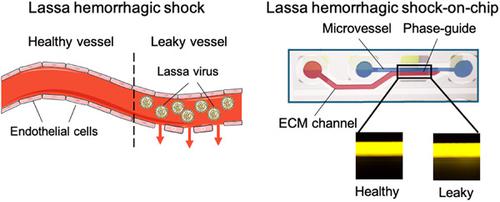当前位置:
X-MOL 学术
›
Biotechnol. Bioeng.
›
论文详情
Our official English website, www.x-mol.net, welcomes your feedback! (Note: you will need to create a separate account there.)
Lassa hemorrhagic shock syndrome‐on‐a‐chip
Biotechnology and Bioengineering ( IF 3.8 ) Pub Date : 2020-11-26 , DOI: 10.1002/bit.27636 Huaqi Tang 1 , Yasmine Abouleila 1 , Alireza Mashaghi 1
Biotechnology and Bioengineering ( IF 3.8 ) Pub Date : 2020-11-26 , DOI: 10.1002/bit.27636 Huaqi Tang 1 , Yasmine Abouleila 1 , Alireza Mashaghi 1
Affiliation

|
Lack of experimental human models hinders research on Lassa hemorrhagic fever and the development of treatment strategies. Here, we report the first chip‐based model for Lassa hemorrhagic syndrome. The chip features a microvessel interfacing collagen network as a simple mimic for extracellular matrix, allowing for quantitative and real‐time vascular integrity assessment. Luminal infusion of Lassa virus‐like particles led to a dramatic increase in vascular permeability in a viral load‐dependent manner. Using this platform, we showed that Fibrin‐derived peptide FX06 can be used to suppress the vascular integrity loss. This simple chip‐based model proved promising in the assessment of disease severity and provides an easy‐to‐use platform for future investigation of Lassa pathogenesis and drug development in a human‐like setting.
中文翻译:

拉沙出血性休克综合征芯片
缺乏实验人体模型阻碍了对拉沙出血热的研究和治疗策略的发展。在这里,我们报告了第一个基于芯片的拉沙出血综合征模型。该芯片具有微血管接口胶原网络作为细胞外基质的简单模拟物,可用于定量和实时血管完整性评估。拉沙病毒样颗粒的腔内输注导致血管通透性以病毒载量依赖性方式显着增加。使用该平台,我们发现纤维蛋白衍生肽 FX06 可用于抑制血管完整性损失。这种简单的基于芯片的模型在评估疾病严重程度方面被证明是有前景的,并为未来在类人环境中研究拉沙病发病机制和药物开发提供了一个易于使用的平台。
更新日期:2020-11-26
中文翻译:

拉沙出血性休克综合征芯片
缺乏实验人体模型阻碍了对拉沙出血热的研究和治疗策略的发展。在这里,我们报告了第一个基于芯片的拉沙出血综合征模型。该芯片具有微血管接口胶原网络作为细胞外基质的简单模拟物,可用于定量和实时血管完整性评估。拉沙病毒样颗粒的腔内输注导致血管通透性以病毒载量依赖性方式显着增加。使用该平台,我们发现纤维蛋白衍生肽 FX06 可用于抑制血管完整性损失。这种简单的基于芯片的模型在评估疾病严重程度方面被证明是有前景的,并为未来在类人环境中研究拉沙病发病机制和药物开发提供了一个易于使用的平台。



























 京公网安备 11010802027423号
京公网安备 11010802027423号